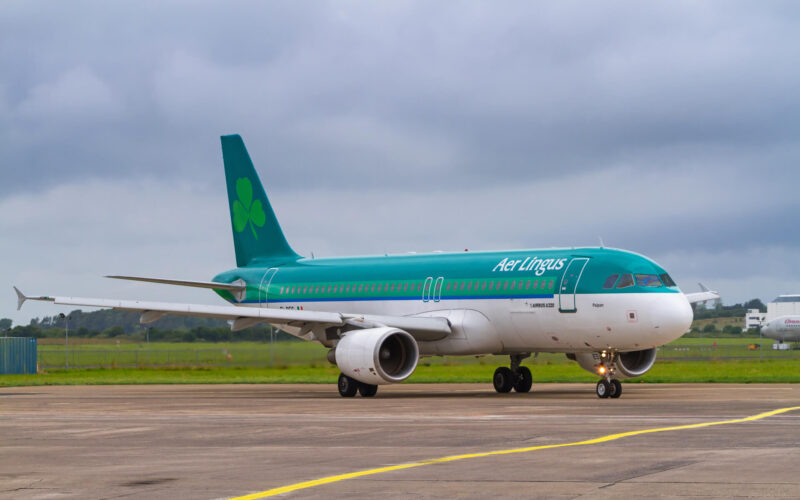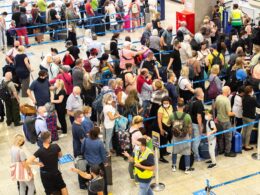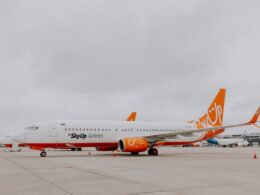Throughout the mid-20th century, Shannon Airport (SNN) on the west coast of Ireland was booming, as airlines used the airport as a stopover before making their trans-Atlantic crossing. Now, the airport’s luck might have run out, as the de facto Irish flag carrier Aer Lingus is lingering with moving its transatlantic services to British cities.
The trouble started to brew when Aer Lingus sought for tenders in the neighboring British island to place its Airbus A321LR (long-range) aircraft and launch new trans-Atlantic routes, as reported by the Irish Times. Six airports emerged as potential origin destinations for Aer Lingus’ new services, including Edinburgh Airport (ED) in Scotland and Manchester Airport (MAN).
If Aer Lingus does withdraw its A321LRs from the Irish airport completely, it could spell big trouble for Shannon as a commercial passenger gateway. But the pot of trouble had begun boiling much before the current pandemic rolled over and flattened the airlines’ plans and in turn, income.
Boeing 737 MAX concerns
The airport had begun bleeding passengers even before the pandemic broke out. The Boeing 737 MAX groundings shrank the airport’s route network, as Norwegian Air Shuttle and Air Canada (ADH2) axed their services from SNN. The Norway-based low-cost carrier discontinued all of its services from Ireland in August 2019, citing the fact that the trans-Atlantic services were “no longer commercially viable.”
“We acknowledge that the grounding of the 737 MAX Jet had a major impact on this decision and Shannon was, among Irish airports, disproportionately affected, as it wiped 120,000 seats off our summer schedule through the suspension of its nine times weekly services from Shannon to Stewart and Providence,” commented the chief executive of Shannon Group Mary Considine at the time.
Air Canada (ADH2), which ran its flights during the summer season, quietly pulled the plug on its Toronto Pearson International Airport (YYZ) – Shannon Airport (SNN) route, inaugurated in June 2018. The Canadian airline noted that it planned to resume its YYZ-SNN flight in the summer 2020 season in an update in April 2019, but plans shifted due to the current situation.
“The unexpected global grounding of the MAX Jet fleet for safety reasons resulted in the loss of 13 services in the peak summer season with Norwegian and Air Canada (ADH2),” Considine commented on the Shannon Group’s 2019 performance.
“This was disappointing and resulted in a reduction in passengers during 2019.” In 2019, the airport lost 8% of its passengers and finished the year with 1.71 million travelers crossing its gates. In 2018, which was the last time when the airport published a detailed breakdown of its passenger numbers, it saw 1.8 million passengers. Among them, 428,512 and 197,114 were transatlantic and transit passengers, respectively, making up for more than 33% of its total traffic.
Losing more transatlantic connections
Aer Lingus‘ potential move from SNN would not be the only trans-Atlantic connection that the airport lost in 2020. In June 2020, United Airlines axed its connection to the Irish airport from New York’s Newark International Airport (EWR). At the time, a spokesperson for the airport commented that the company was “disappointed with the decision by United,” SNN was “pleased that American Airlines (A1G) (AAL), Delta and Aer Lingus have indicated that they will resume their transatlantic services from Shannon in 2021.”
During the course of the pandemic, Shannon also lost an iconic flight number on its flight board, BA1. Operated by British Airways Airbus A318, the Baby Bus as it is nicknamed departed from London City Airport (LCY), stopped over in SNN and crossed the Atlantic Ocean, landing in New York John F. Kennedy International Airport (JFK). Previously, the BA1 flight code belonged to Concorde’s connection from London Heathrow Airport (LHR) to JFK.
Now, Aer Lingus is considering withdrawing from Shannon, together with two Airbus A321LR aircraft. Local media reports indicate that the airline’s preliminary plans are to start the transatlantic flights in 2021. The flights would be operated for at least three years.
An Aer Lingus representative stated that the airline had “no comment” on the reports.
Not all doom and gloom
Yet the spillage of Aer Lingus plans to move transatlantic flights across the Irish Sea might be a bluff as well. Aer Lingus updated its summer 2021 schedule, which includes a SNN-JFK daily connection utilizing the A321LR, reported Routesonline in early-August 2020.
The airline has been vocal about the government’s policies during the pandemic.
“The full economic consequences of such a shift in policy and of Ireland being ‘Closed for Business’ would be profound and will need to be assessed and quantified,” read a statement by Aer Lingus on July 6, 2020. “There are inevitable consequences for the prospects of recovery in the aviation and tourism sectors and for employment within these sectors.”
It would not be a far-fetched assumption that the company is threatening to withdraw from Shannon, which would eliminate crucial connectivity from the region. At the end of the day, the blame would eventually fall on the government if the move cost jobs and people’s livelihoods in the Irish mid-west.
The region is already at a sensitive place. Dee Ryan, Limerick’s Chamber of Commerce chief executive, told the Irish Times that it was “vital that the regional imbalances already facing this country are not worsened by COVID-19.” According to Social Justice Ireland, an independent think tank, the region had an unemployment rate of 4.9%, while the state average was 4.5% in Q4 2019.
For Shannon Group, the parent company of the airport, the move was seemingly inevitable. The company has been on a quest to improve its ancillary revenue, including for property on the airport grounds. Commercial property revenue increased from €10. 8 million ($12.9 million) to €13.4 million ($16 million) in 2019. Furthermore, Shannon Group highlighted that reliance on air traffic was a risk to the group’s business. It was something that could not be controlled, as air traffic at SNN depended on “the future strategies and financial strengths of core airline customers.”
To mitigate the risk, including the fact that it is focused on the airport’s cost competitiveness, the company has started to diversify its products. It targets new customers to develop new revenue streams, something that Shannon Group has defined as its “key strategic objective.”
“In 2019 we saw 14 new indigenous and overseas aviation businesses locate in Shannon,” commented chief executive Mary Considine. “This is a clear indication that the Shannon aviation brand, which our International Aviation Services Centre (IASC) is endeavoring to promote, is having a real impact.”












